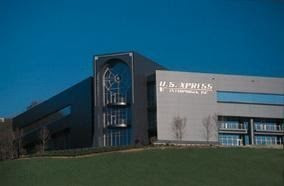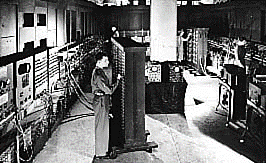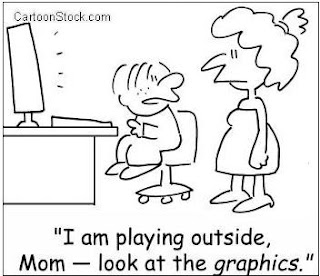(c) Desktop publishing: Producing finished business literature is one of the uses of computer in business. Using desktop publishing programs, or even sophisticated word processing programs, people can create sales letters, brochures, price lists, newsletters, and even book-length manuals.
(d) Financial analysis: Financial analysis is performed throughout the company, from top management to down. People can analyse investments, sales, expenses, markets and other aspects of the business using both numbers and graphs.
Computer in Commercial
Many business companies, large or small use computers to help in the control of daily activities.
Some of the more common uses are:
(a) Employee records: All organizations keep record of their employees. An employee record normally contains information such as name, address, telephone number, present job classification, date of start of employment, contract period, salary scale or rate of pay, allowances, deductions, salary paid to date, taxes deducted to date, etc. Using a computer, it is a simple matter to store, retrieve and update information concerning employees. The most frequent use of an employee record is in payroll processing.
(b) Payroll processing: With the employee record we have almost every information of an employee. Regarding the payroll the fields such as employee name, address, job classification, rate of pay, fixed allowances, fixed deductions etc., are important. With different information such as number of hours worked by each employee, fixed allowances, fixed deductions etc., the gross pay is calculated.(c) Accounts receivable: An account receivable system keeps track of all money owed to the company by its customers. e.g., consider a department store which offers credit to selected customers. For each customer record is created which include date such as customer name, address, telephone number, occupation, credit limit, amount owed by the customer, date of last purchase, date of last payment, etc. The date of last purchase, date of last payment data items are used by the computer to determine the length of time for which the customer has owed money to the store. Based on this time a notice can be sent to the customer, if he/she is too late to pay.
(d) Account payable: An accounts payable system keeps records of people to which the company owes money. These are usually the people who provide goods and services to the company. This system enables the company to schedule its payments in a way which is in the best interests of the company.
(e) Stock control: A stock control system enables a user to mange his stock more effectively. At the heart of the system is the file of stock items. For each item in stock, an ‘item record’ is created. Each item is assigned a unique identifier (usually a number). This number is used in all transactions to do with the item.
Computer in Industry
Computers have had a major impact in industries where products are designed and manufactured. Computer Aided Design (CAD) is used to develop products. Computer Aided Manufacturing (CAM) is used to produce them.
(b) Factories: Factory floors are becoming increasingly populated by computers used for many purposes including inventory control and planning and process control. Computers are also used to run robots that create, finish, assemble, and test products and their components.
Computer in Health Care and Medical field
Computers are widely used in hospitals to help doctors in diagnosis, getting information on patients, diseases, treatment, drugs etc. They are also used in administration and in keeping patient records. Doctors can get information from distant data banks and expert systems. They can discuss with colleagues using teleconferencing. Many devices take images and diagnose diseases. Examples are Computerized Axial Tomography (CAT), Position Emission Tomography (PET), Magnetic Resonance Imaging (MRI), etc. These devices take pictures of brain and help in diagnosis of various kinds of diseases. There are a lot of computerized automatic medical equipment's which help in diagnosis of diseases such as CT scan machine, Eye testing machines, Ultra sonography equipment, etc.
Computer in Education
Computers have been used in schools since the first Apples were introduced in the 1970. However, their impact was limited then because there were not enough computers and educational computer programming was poor. As technology has advanced education, software has become a major influence at all levels from elementary schools to universities. The ability to connect computers and students together over a network such as the Internet opens up fantastic educational opportunities.
(a) Research and Universities: Scientific and engineering design and research work involve complex and massive computations. In many cases, simulation is also required. Such complex computations are not possible by hand calculators. So, computers are must for this type of work.
(b) Library: A typical library contains thousand of books, magazines, reports and other documents which users may wish to borrow. A small library may have several hundred prospective borrowers, while the number of users of larger libraries can reach beyond thousands. Maintaining records of books and borrowers is well suited to a computer system. Using a computer enables library personnel to answer queries about the status of books more easily than if a manual system was being used. A computerized system also enables to find out whether to issue books to the users or not. If the maximum limit of the book is already reached then that user will not get the book.
Computer in Engineering
Computer Applications in Engineering Education provides timely information on the innovative uses of computers and software tools in education, and for accelerating the integration of computers into the engineering curriculum. In modern times, computers have closely connection with everyone, especially scientist and engineer. Computer programs can now solve difficult problems in a fraction of the time it used to take. Computer-aided engineering is a powerful tool and necessary for engineering design and manufacture.
Nowadays, you no longer have to write your own software programs to use computers effectively. In chemical engineering, a lot of softwares are used in the process of chemical operation, like the software for process of chemical engineering Proa! and Aspen, and Computational fluid dynamics software Fluent and CFX and so on.
Computer in Graphics
Today, computers and computer-generated images touch many aspects of daily life. Computer graphics is found on television, in newspapers, for example, in weather reports, or for example, in all kinds of medical investigation and surgical procedures.
The development of computer graphics, has made computers easier to interact with and better for understanding and interpreting many types of data. Computer imagery has applications for film special effects, simulation and training, games, medical imagery, flying logos, etc. Although computer graphics is a vast field that encompasses almost any graphical aspect, it mainly interested in the generation of images of three-dimensional scenes.
ALSO SEARCH:
"10 applications of computer"
"applications of computer"
"what are the five applications of computer"
"basic applications of computer"
"20 applications of computer"
"applications of computer in education"
"types of computer applications"










